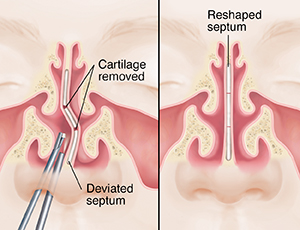Nasal Surgery: Septoplasty
Septoplasty is a surgical procedure designed to correct a deviated septum. This is the thin wall of cartilage and bone that separates the nostrils. When the septum is significantly off-center, it can block airflow, leading to breathing difficulties, recurrent sinus infections, and other related issues. Septoplasty attempts to straighten the septum as much as possible and open the airway by removing the deviated portion and repairing the remaining bone and cartilage.
What to expect during septoplasty
This surgery repairs a blockage inside the nose caused by a deviated septum. With a deviated septum, there's a problem with the wall that divides the nose into 2 chambers. A deviated septum may block air coming through 1 or both nostrils. This makes it harder for you to breathe through your nose. During septoplasty, the surgeon makes cuts (incisions) inside the nose. Then the surgeon trims, reshapes, moves, or removes cartilage and sometimes bone from the septum.

Risks
As with any surgery, nasal surgery has some risks. Your healthcare provider will discuss risks and possible complications with you. These may include:
Bleeding
Infection
Decreased sense of smell
Temporary numbness of teeth and nose
A hole in your septum
Collection of blood in nasal spaces
Change in shape of nose.
After septoplasty
After septoplasty, you’ll be taken to the postanesthesia care unit (PACU) to be monitored as you wake up from anesthesia. Your experience may be as follows:
-
You may have packing material inside your nose. This reduces bleeding and helps with healing. You may also have bandages (dressings) on the outside of your nose.
-
It’s normal to have some mucus and blood drain from your nose. Until packing is removed, you will have to breathe through your mouth.
-
You may have some swelling or bruising around your eyes.
-
Expect some throat dryness and irritation.
-
Pain medicine will be prescribed as needed. Talk with your healthcare provider about medicine you shouldn't take after your procedure.
Follow-up care
You’ll need to follow up with your healthcare provider after your surgery. Here's what to expect:
-
Any packing, splint, or dressings will likely be removed. You may feel mild pain and bleed a little when this is done.
-
After the splint or packing is removed, you’ll most likely breathe better than you did before surgery.
-
You may have minor numbness, pain, swelling, and a little stiffness under the tip of the nose.
-
In a few days, the inside of your nose may swell. Or a scab or crust may make it hard to breathe through your nose again. Leave the scab alone. Your healthcare provider can remove it. Using saline (irrigation or aerosol) regularly as directed after surgery helps to reduce the amount of crusting at each visit.
-
Contact your provider if you have any questions or concerns.
Online Medical Reviewer:
Rita Sather RN
Online Medical Reviewer:
Sabrina Felson MD
Online Medical Reviewer:
Sravani Chintapalli
Date Last Reviewed:
3/1/2024
© 2000-2024 The StayWell Company, LLC. All rights reserved. This information is not intended as a substitute for professional medical care. Always follow your healthcare professional's instructions.